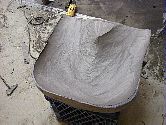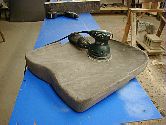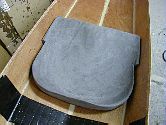
 |
||||
| back to page 18 | INDEX | back to 18a |
 |
Different view. Needless to say, this operation is best done outside or with good ventilation. Fortunately, the black dust is heavy, settles quickly and is easy to clean. When I swept the floor afterwards, it was barely a handful even though the volume of the block was reduced at least by 40%. The foam shrinks when heated to high temperature and most of the volume in the foam is gas so it is not surprising. |
 |
Now is the time to erase the grinder marks with an orbital sander. I use 100 grit paper. The sander is excellent in rounding and smoothing the corners, bumps and scars. Use this tool to bring out the nice velvety texture. By the way, it is also perfect for eliminating the foam crust on the thick blocks. Use the same procedure as with the grinder. |
 |
Finished
seat. 10oz. (300g)! I find this to be good enough. If you want perfection, keep sanding and/or use finer sandpaper. This seat was just a block of foam 60 minutes ago. Some builders finish it off with spandex fabric glued to the foam. Spandex will contour pretty much most compound curves. You can also carve a bottle holder in the seat which I will likely do later, once the seat is tested in action. |
 |
Glue
it into the kayak with a few dabs of GOOP glue or make it removable with
a few strips of self-stick Velcro (hook and loop) strips. Make sure to test
it in the kayak first before gluing it down permanently. Order your Minicel on-line . For other options see the Ordering page. |
| BACK to page 18 | INDEX | previous Minicel seat page |
| Home | Kayak Designs | Kayak Shop | Materials | Kayak Gallery | About us |
| Building Manual | Plans | Sandwich Core | Wood Kayak | Order | |
| Epoxy Test | Abrasion Cloth | Rudder | Resources | Choosing Kayak | Guestbook |
If you notice any problems with the site (i.e. error links, missing images) please, let me know. Thanks
Mail:
Vaclav Stejskal
58 Wood Ln.
Acton, MA 01720
USA
Tel: 781-481-9261
© 1999
- 2024 Copyright Vaclav Stejskal
All rights reserved
Last page update:
9 May 2024